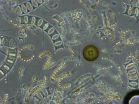Moffitt develops new method to characterize the structure of a protein that promotes tumor growth
Using a new assay, researchers find the structure of MDMX that controls its own interaction with tumor suppressor protein p53
2015-04-13
(Press-News.org) TAMPA, Fla. - Moffitt Cancer Center researchers have developed a new method to identify a previously unknown structure in a protein called MDMX. MDMX is a crucial regulatory protein that controls p53 - one of the most commonly mutated genes in cancer.
Known as the tumor suppressor gene, p53 protects the body from cancer development by ensuring that DNA remains intact and does not have mutations. If p53 senses DNA damage, it can either stimulate the cells to repair its DNA, or cause cells to stop growing and undergo cell death. Because of its functions, p53 is often called "the guardian of the genome." Mutations in p53 can inactivate its function and lead to cancer development. It is estimated that more than half of all cancers have p53 mutations.
Despite the importance of p53, too much p53 activity could also be a detriment to cells. Therefore, an intricate regulatory network has evolved to block excessive p53 activity, including MDMX that binds to p53 to block its activity.
Moffitt scientists study the structure of MDMX to understand how it blocks p53 activity and to use this information in the development of cancer therapeutic drugs. However, many techniques commonly used to study protein structures have different drawbacks, limiting their usefulness on MDMX.
The researchers developed a novel technique called the proteolytic fragment release assay to analyze the MDMX protein. This assay allows scientists to determine how different segments of a protein interact with one another.
They discovered that a segment of MDMX functions as an auto-inhibitor of its own activity. When MDMX is in a closed structure with the auto-inhibitory segment, it cannot bind to p53. As a result, p53 can either repair DNA or stimulate cell death. However, if MDMX has a more open structure, it binds to p53 and blocks DNA repair and cell death.
"Our biochemical study of this protein over the past decade has facilitated the development of an MDMX drug that has recently entered clinical trial. The current finding suggests that analyzing the state of MDMX protein in tumors may help identify patients that are more likely to respond to the drug," said Jiandong Chen, Ph.D., senior member of Moffitt's Cancer Biology and Evolution Program. "This publication is a significant step forward in our basic research to help the development of next generation MDMX-targeted cancer drugs. Investigators with expertise in molecular biology, biochemistry, and structural biology working together really helped bring our understanding to a higher level than each of us working alone."
INFORMATION:
The research article was published in the March 30 issue of the journal Proceedings of the National Academy of Sciences and was supported by grants received from the National Institutes of Health (CA141244, CA109636 and P30-CA076292) and the Florida Department of Heath (4BB14).
About Moffitt Cancer Center
Located in Tampa, Moffitt is one of only 41 National Cancer Institute-designated Comprehensive Cancer Centers, a distinction that recognizes Moffitt's excellence in research, its contributions to clinical trials, prevention and cancer control. Moffitt is the top-ranked cancer hospital in the Southeast and has been listed in U.S. News & World Report's "Best Hospitals" for cancer care since 1999. With more than 4,500 employees, Moffitt has an economic impact in Florida of nearly $1.6 billion. For more information, visit MOFFITT.org, and follow the Moffitt momentum on Facebook, Twitter and YouTube.
ELSE PRESS RELEASES FROM THIS DATE:
2015-04-13
ATLANTA--Chimpanzees are capable of some degree of planning for the future, in a manner similar to human children, while some species of monkeys struggle with this task, according to researchers at Georgia State University, Wofford College and Agnes Scott College.
Their findings were published on March 23 in the Journal of Comparative Psychology.
The study assessed the planning abilities of chimpanzees, two monkey species (rhesus macaques and capuchin monkeys) and human children (ages 28 to 66 months old) using a computerized game-like program that presented 100 unique ...
2015-04-13
A workplace intervention designed to reduce work-family conflict gave employed parents more time with their children without reducing their work time.
"These findings may encourage changes in the structure of jobs and culture of work organizations to support families," said Kelly Davis, research assistant professor of human development and family studies.
The research is part of the Work, Family and Health Network's evaluation of the effects of a workplace intervention designed to reduce work-family conflict by increasing both employees' control over their schedule ...
2015-04-13
(Boston) - Emergency departments (ED) provide a promising venue to address opioid deaths with education on both overdose prevention and appropriate actions in a witnessed overdose. In addition, ED's have the potential to equip patients with nasal naloxone rescue kits as part of this effort.
These findings are from a study published in the Western Journal of Emergency Medicine, and is the first study to demonstrate the feasibility of ED-based opioid overdose prevention education and naloxone distribution to trained laypersons, patients and their social network.
In ...
2015-04-13
PROVIDENCE, R.I. [Brown University] -- Researchers from Brown University and the University of Rhode Island have demonstrated a promising new way to increase the effectiveness of radiation in killing cancer cells.
The approach involves gold nanoparticles tethered to acid-seeking compounds called pHLIPs. The pHLIPs (pH low-insertion peptides) home in on high acidity of malignant cells, delivering their nanoparticle passengers straight to the cells' doorsteps. The nanoparticles then act as tiny antennas, focusing the energy of radiation in the area directly around the cancer ...
2015-04-13
CORVALLIS, Ore. - Researchers at Oregon State University have discovered how vitamin E deficiency may cause neurological damage by interrupting a supply line of specific nutrients and robbing the brain of the "building blocks" it needs to maintain neuronal health.
The findings - in work done with zebrafish - were just published in the Journal of Lipid Research. The work was supported by the National Institutes of Health.
The research showed that zebrafish fed a diet deficient in vitamin E throughout their life had about 30 percent lower levels of DHA-PC, which is a ...
2015-04-13
PITTSBURGH, April, 13, 2015 - A serendipitous combination of technology and scientific discovery, coupled with a hunch, allowed University of Pittsburgh Cancer Institute (UPCI) researchers to reveal a previously invisible biological process that may be implicated in the rapid growth of some cancers.
The project, funded by the National Institutes of Health (NIH), is described in today's issue of the Proceedings of the National Academy of Sciences (PNAS).
"I was so amazed by what I was seeing," said lead author Masahiro Shuda, Ph.D., research assistant professor in Pitt's ...
2015-04-13
HOUSTON - (April 13, 2015) - For decades, scientists and physicians have puzzled over the fact that infants with the postnatal neurodevelopmental disorder Rett syndrome show symptoms of the disorder from one to two years after birth.
In a report in the Proceedings of the National Academy of Sciences, Dr. Huda Zoghbi and her colleagues from Baylor College of Medicine and the Jan and Dan Duncan Neurological Research Institute at Texas Children's Hospital, unravel the mystery by looking at when and how the causal gene involved (methyl-CpG binding protein 2 or MECP2) binds ...
2015-04-13
Fresh insights into how bacteria protect themselves - by forming a waterproof raincoat - could help develop improved products to protect plants from disease.
Researchers have discovered how communities of beneficial bacteria form a waterproof coating on the roots of plants, to protect them from microbes that could potentially cause plant disease.
Their insights could lead to ways to control this shield and improve its efficiency, which could help curb the risk of unwanted infections in agricultural or garden plants, the team says.
Scientists at the Universities of ...
2015-04-13
A new analysis of the chemical make-up of meteorites has helped scientists work out when the Earth formed its layers.
The research by an international team of scientists confirmed the Earth's first crust had formed around 4.5 billion years ago.
The team measured the amount of the rare elements hafnium and lutetium in the mineral zircon in a meteorite that originated early in the solar system.
"Meteorites that contain zircons are rare. We had been looking for an old meteorite with large zircons, about 50 microns long, that contained enough hafnium for precise analysis," ...
2015-04-13
Diversity of life abounds on Earth, and there's no need to look any farther than the ocean's surface for proof. There are over 200,000 species of phytoplankton alone, and all of those species of microscopic marine plants that form the base of the marine food web need the same basic resources to grow--light and nutrients.
A study by a team of scientists from the Woods Hole Oceanographic Institution (WHOI), University of Rhode Island (URI), and Columbia University, published April 13 in the Proceedings of the National Academy of Sciences reveals how species of diatoms--one ...
LAST 30 PRESS RELEASES:
[Press-News.org] Moffitt develops new method to characterize the structure of a protein that promotes tumor growth
Using a new assay, researchers find the structure of MDMX that controls its own interaction with tumor suppressor protein p53

